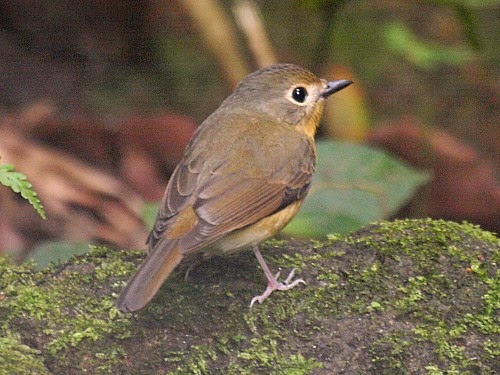We were out around the chilly campsite early and there was plenty happening with a mixed flock of White-necked and Black-throated Laughingthrushes showing well in the surrounding scrub - I had seen both species on a previous trip to near the Burmese border but both species had proved extremely skulking on that occasion. A pair of Coral-billed Scimitar-Babblers then appeared amongst them but they did prove skulking and quickly moved off up the hillside. Annan appeared with a cup of coffee for us before we left at 7am, but to our surprise, in the opposite direction to the Rusty-naped Pitta we had heard calling the previous evening. He lead the way on his moped and we followed for a couple of kilometres down the road until reaching a wet ravine where we walked along a short forest trail into the darkness. We crouched in a small low makeshift photographic blind and Annan proceeded to imitate the call of a Rusty-naped Pitta for an hour or so before leaving us to it. A steady procession of good species were seen including a Rufous-browed Flycatcher, a couple of Streaked Wren-babblers, a pair of superb Spot-necked Babblers, a few White-tailed Robins and a very obliging White-crowned Forktail. Midday came and went and we hadn't even heard, let alone seen, any sign of the Pitta but we stuck it out. Then, early afternoon, we were watching a Blue Whistling Thrush and a White-tailed Robin when suddenly a much larger bird flew in and chased them and everything disappeared. In the split instant it felt like we were in the presence of the Pitta. JFC has successfully picked-out Pittas by carefully and slowly scanning the undergrowth and whilst employing that tactic I saw its large eye! Virtually wholly-concealed in the thick undergrowth, it was motionless, presumably surveying the scene, and I could only see part of its rusty face and some of its green upperparts and then it simply hopped to the right and was gone. Would that be it? What was it best to do? Time went on, and minutes felt like hours, with no further sign. By carefully scanning, I then noticed it again, but as before virtually wholly obscured and it again soon hopped out of sight - at least it was still around. Then suddenly there was another commotion and it appeared almost in the open at the stream side where it then showed on and off for the next 10 minutes even enabling us to photograph it. Elated, we left the ravine and drove back to the campsite. We met a Thai birder who had just photographed a pair of Grey Peacock-Pheasants behind the new toilet block at the campsite and Annan hurriedly appeared with a couple of pop-up hides and some rice and took us to the area. Whilst no Peacock-Pheasants appeared, three Rufous-throated Partridges did, and another pair of Coral-billed Scimitar-Babblers were seen moving through the area. We weren't sure whether to continue to wait in hope of the Peacock-Pheasants or to try again for Rufous-necked Hornbill from the viewpoint but we opted for the latter, again without success, although a pair of Silver-eared Mesias were seen feeding in the bushes there and a Radde's Warbler was a nice surprise. We decided on a night drive and heard many Mountain Scops Owls calling but failed to entice any into view. Then a surprise in hearing a calling Oriental Bay Owl and it wasn't far away. We felt sure it would respond to playback, but whilst it happily called back for the next half an hour or so and it moved around, it always kept its distance and frustratingly we couldn't see it.
Rufous-throated Partridge 3
Mountain Imperial Pigeon 2
Oriental Bay Owl h
Mountain Scops Owl h
Rusty-naped Pitta 1
Grey-backed Shrike 1
Hair-crested Drongo 10
White-throated Fantail 1
Flavescent Bulbul 10
Radde's Warbler 1
CORAL-BILLED SCIMITAR-BABBLER 4
SPOT-NECKED BABBLER 2
Streaked Wren-Babbler 2
Buff-breasted Babbler 10
White-necked Laughingthrush 4
Black-throated Laughingthrush 20
Silver-eared Mesia 2
Rufous-browed Flycatcher 1
Hill Blue Flycatcher 2
Large Niltava 2
White-tailed Robin 4
White-crowned Forktail 1
Blue Whistling Thrush 4
Blue Rock Thrush 1
Streaked Spiderhunter 1
Black-throated Laughingthrush at Chong Yen, Mae Wong NP
White-necked Laughingthrushes at Chong Yen, Mae Wong NP
Coral-billed Scimitar-Babbler at Chong Yen, Mae Wong NP
Record shots are always more gripping, perhaps not, but a pity the camera didn't focus where the bird was! It does just about show the diagnostic buff-coloured underparts and the thick glowing coral-coloured bill of the species being more akin to a Royal Tern than a Scimitar-Babbler!
Wet ravine near Chong Yen, Mae wong NP
White-throated Fantail near Chong Yen, Mae Wong NP
Buff-breasted Babbler near Chong Yen, Mae Wong NP
Female Hill Blue Flycatcher near Chong Yen, Mae Wong NP
The uniformity of this individual's throat with its breast and the gradual gradation from its orange breast to its white belly supports the identification as this species.
Rufous-browed Flycatcher near Chong Yen, Mae Wong NP
Chestnut-crowned Laughingthrush near Chong Yen, Mae Wong NP
Blue Whistling Thrush near Chong Yen, Mae Wong NP
Of one of the smaller black-billed forms.
White-tailed Robin near Chong Yen, Mae Wong NP
White-crowned Forktail near Chong Yen, Mae Wong NP
Streaked Wren-babbler near Chong Yen, Mae Wong NP
Spot-necked Babbler near Chong Yen, Mae Wong NP
Rusty-naped Pitta near Chong Yen, Mae Wong NP
I had previously been fortunate enough to have seen Rusty-naped Pitta on several occasions in the Temple Gulley at Doi Chang Dao in 1999, but seeing any species of Pitta is always special, and this one ensured I have been fortunate to have seen Pittas on all four of my visits to Thailand.
Rufous-throated Partridge at Chong Yen, Mae Wong NP
Silver-eared Mesia at Chong Yen, Mae Wong NP
Flavescent Bulbul at Chong Yen, Mae Wong NP
Blue rock Thrush at Chong Yen, Mae Wong NP












































































